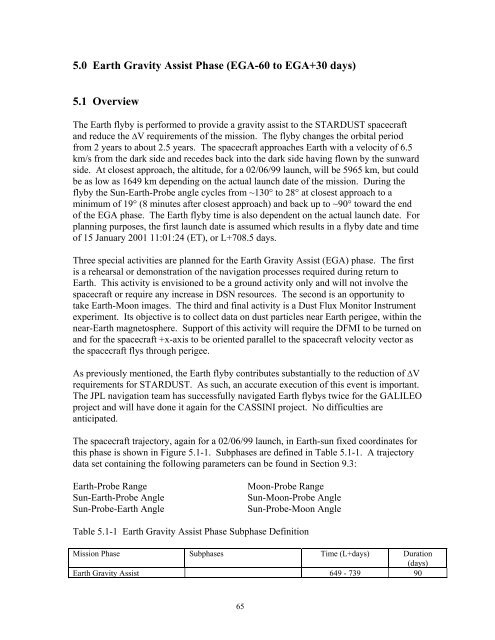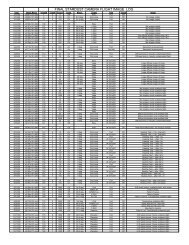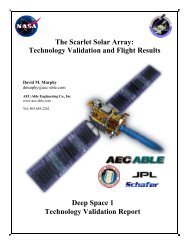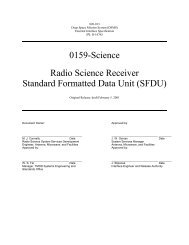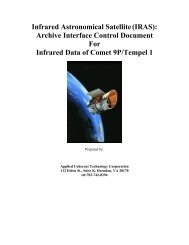MISSION PLAN - PDS Small Bodies Node
MISSION PLAN - PDS Small Bodies Node
MISSION PLAN - PDS Small Bodies Node
Create successful ePaper yourself
Turn your PDF publications into a flip-book with our unique Google optimized e-Paper software.
5.0 Earth Gravity Assist Phase (EGA-60 to EGA+30 days)<br />
5.1 Overview<br />
The Earth flyby is performed to provide a gravity assist to the STARDUST spacecraft<br />
and reduce the ∆V requirements of the mission. The flyby changes the orbital period<br />
from 2 years to about 2.5 years. The spacecraft approaches Earth with a velocity of 6.5<br />
km/s from the dark side and recedes back into the dark side having flown by the sunward<br />
side. At closest approach, the altitude, for a 02/06/99 launch, will be 5965 km, but could<br />
be as low as 1649 km depending on the actual launch date of the mission. During the<br />
flyby the Sun-Earth-Probe angle cycles from ~130° to 28° at closest approach to a<br />
minimum of 19° (8 minutes after closest approach) and back up to ~90° toward the end<br />
of the EGA phase. The Earth flyby time is also dependent on the actual launch date. For<br />
planning purposes, the first launch date is assumed which results in a flyby date and time<br />
of 15 January 2001 11:01:24 (ET), or L+708.5 days.<br />
Three special activities are planned for the Earth Gravity Assist (EGA) phase. The first<br />
is a rehearsal or demonstration of the navigation processes required during return to<br />
Earth. This activity is envisioned to be a ground activity only and will not involve the<br />
spacecraft or require any increase in DSN resources. The second is an opportunity to<br />
take Earth-Moon images. The third and final activity is a Dust Flux Monitor Instrument<br />
experiment. Its objective is to collect data on dust particles near Earth perigee, within the<br />
near-Earth magnetosphere. Support of this activity will require the DFMI to be turned on<br />
and for the spacecraft +x-axis to be oriented parallel to the spacecraft velocity vector as<br />
the spacecraft flys through perigee.<br />
As previously mentioned, the Earth flyby contributes substantially to the reduction of ∆V<br />
requirements for STARDUST. As such, an accurate execution of this event is important.<br />
The JPL navigation team has successfully navigated Earth flybys twice for the GALILEO<br />
project and will have done it again for the CASSINI project. No difficulties are<br />
anticipated.<br />
The spacecraft trajectory, again for a 02/06/99 launch, in Earth-sun fixed coordinates for<br />
this phase is shown in Figure 5.1-1. Subphases are defined in Table 5.1-1. A trajectory<br />
data set containing the following parameters can be found in Section 9.3:<br />
Earth-Probe Range<br />
Sun-Earth-Probe Angle<br />
Sun-Probe-Earth Angle<br />
Moon-Probe Range<br />
Sun-Moon-Probe Angle<br />
Sun-Probe-Moon Angle<br />
Table 5.1-1 Earth Gravity Assist Phase Subphase Definition<br />
Mission Phase Subphases Time (L+days) Duration<br />
(days)<br />
Earth Gravity Assist 649 - 739 90<br />
65


